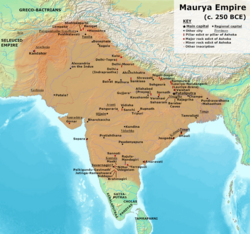Maurya Dynasty
| Maurya Empire | ||||||||||||||||||||
| मौर्यसाम्राज्यम् | ||||||||||||||||||||
|
||||||||||||||||||||
|
Maurya Empire at its maximum extent
|
||||||||||||||||||||
| Capital |
Pataliputra (Present-day Patna, Bihar) |
|||||||||||||||||||
| Languages | Old Indic Languages (e.g. Magadhi Prakrit, Other Prakrits) | |||||||||||||||||||
| Religion |
Hinduism (Brahmanism) Buddhism Jainism Ājīvika |
|||||||||||||||||||
| Government | Absolute monarchy as described in Chanakya's Arthashastra | |||||||||||||||||||
| Emperor | ||||||||||||||||||||
| • | 322–298 BCE | Chandragupta | ||||||||||||||||||
| • | 298–272 BCE | Bindusara | ||||||||||||||||||
| • | 268–232 BCE | Ashoka | ||||||||||||||||||
| • | 232–224 BCE | Dasharatha | ||||||||||||||||||
| • | 224–215 BCE | Samprati | ||||||||||||||||||
| • | 215–202 BCE | Shalishuka | ||||||||||||||||||
| • | 202–195 BCE | Devavarman | ||||||||||||||||||
| • | 195–187 BCE | Shatadhanvan | ||||||||||||||||||
| • | 187–185 BCE | Brihadratha | ||||||||||||||||||
| Historical era | Antiquity | |||||||||||||||||||
| • | Established | 326 BCE | ||||||||||||||||||
| • | Disestablished | 187 BCE | ||||||||||||||||||
| Area | ||||||||||||||||||||
| • | 250 BC | 5,000,000 km² (1,930,511 sq mi) | ||||||||||||||||||
| Currency | Panas | |||||||||||||||||||
|
||||||||||||||||||||
| Maurya Kings (322 BCE – 180 BCE) | |
| Chandragupta | (322–297 BCE) |
| Bindusara | (297–272/268 BCE) |
| Ashoka | (272/268–232 BCE) |
| Dasharatha | (232–224 BCE) |
| Samprati | (224–215 BCE) |
| Shalishuka | (215–202 BCE) |
| Devavarman | (202–195 BCE) |
| Shatadhanvan | (195–187 BCE) |
| Brihadratha | (187–180 BCE) |
|
Pushyamitra (Shunga Empire) |
(180–149 BCE) |
The Maurya Empire was a geographically extensive Iron Age historical power founded by Chandragupta Maurya which dominated ancient India between c. 322 and 187 BCE. Originating from the kingdom of Magadha in the Indo-Gangetic Plain in the eastern side of the Indian subcontinent, the empire had its capital city at Pataliputra (modern Patna). The empire was the largest to have ever existed in the Indian subcontinent, spanning over 5 million square kilometres at its zenith under Ashoka.
Chandragupta Maurya, raised an army and with the assistance of Chanakya, overthrew the Nanda Empire in c. 322 BCE and rapidly expanded his power westwards across central and western India taking advantage of the disruptions caused by the withdrawal westward by Alexander the Great's armies. By 316 BCE the empire had fully occupied Northwestern India, defeating and conquering the satraps left by Alexander. Chandragupta then defeated the invasion led by Seleucus I, a Macedonian general from Alexander's army, gaining additional territory west of the Indus River.
The Maurya Empire was one of the largest empires of the world in its time. At its greatest extent, the empire stretched to the north along the natural boundaries of the Himalayas, to the east into Assam, to the west into Balochistan (south west Pakistan and south east Iran) and the Hindu Kush mountains of what is now Afghanistan. The Empire was expanded into India's central and southern regions by the emperors Chandragupta and Bindusara, but it excluded a small portion of unexplored tribal and forested regions near Kalinga (modern Odisha), until it was conquered by Ashoka. It declined for about 50 years after Ashoka's rule ended, and it dissolved in 185 BCE with the foundation of the Shunga dynasty in Magadha.
...
Wikipedia

